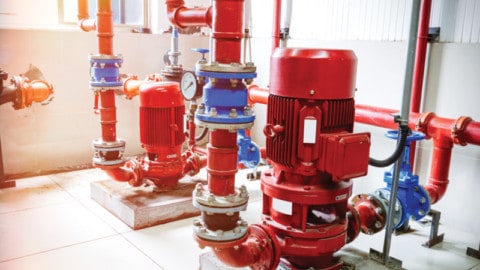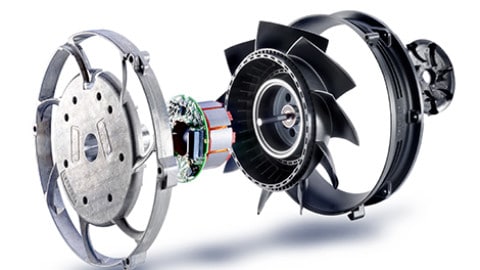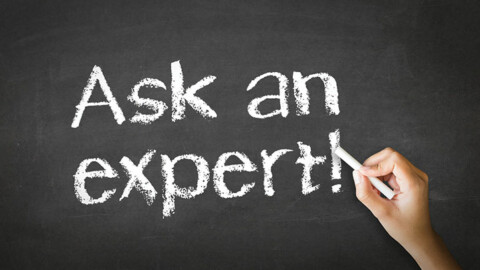Pumps are the heart of many HVAC systems, providing the energy needed to move water and other fluid through piping, fittings and equipment. When selecting a pump for a HVAC application, there are a number of factors to be considered such as operating expenses, energy costs, system reliability and longevity. Using a systems approach to focus on the total system performance rather than individual components will aid in the selection of an optimally operating pump that will last. Here, we look at the most common types of pump used in HVAC applications, selection considerations and system selection.
Types of pump used in HVAC systems
The most common type of pump used in HVAC systems today is the centrifugal pump, with circulator, end suction, split case and vertical in-line types found in this application.
Circulator pumps
Circulator pumps are typically used in low pressure, low-capacity systems, and are designed to circulate water through a closed system where the fluid runs in a loop between the discharge line and the suction without ever being exposed to atmospheric pressure.
They can also be used in a completely closed system, in which case there is usually an expansion tank attached to the pump’s suction line to prevent the pipes from becoming over pressurised and bursting as the water expands.
They are most commonly single stage, and the size of the system is typically under 150 gpm and not rated for more than 125 psig operating pressure. Small systems found in homes and small commercial hydronic heating systems are designed to be close coupled to eliminate the need for a mechanical seal, and include a centrifugal wet rotor.
On the other hand, high flow versions are designed as vertical in-line pumps with mechanical seals. They are usually mounted directly in and supported by the piping system, with the motor available in either vertical or horizontal position.
End suction
End suction pumps have a casing with the suction on one end and the discharge at the top. They are usually single stage and can either be close or flexible coupled. A close-coupled pump has the impeller directly mounted to the motor shaft, while a flexible-coupled pump has the impeller and the motor shaft separated by a flexible coupling.
One of the benefits of using a close-coupled pump is that the alignment of the motor shaft to the impeller is fixed, whereas a flexible-coupled pump has the risk of this becoming misaligned during maintenance, which can cause problems if it is not properly reassembled. In both cases, the pump is typically installed on a solid base on the floor.
In HVAC applications, end suction pumps with capacities up to 4000 gpm and 150ft of head are usually used. Close-coupled pumps have the advantage of taking up less floor space, but on the downside the motor is typically specially matched to the shaft type and seals used. Flexible-coupled pumps have the advantage of typically using a standard motor.
Split case
Like end suction pumps, split case pumps are flexible coupled, with the assembly mounted to a baseplate. Pump suction and discharge are arranged in the horizontal direction and are perpendicular to the shaft.
They are available in single suction (the water enters the impeller from only one side) or double suction (the fluid enters the impeller from both sides) models. Double suction versions are preferred over single suction as they reduce the risk of hydraulic imbalance.
These pumps are also available with multiple impellers for multistage operation. While these pumps can be horizontal or vertical split case, horizontal split case pumps are more commonly used in HVAC applications.
Horizontal split case pumps are designed with the casing split on a horizontal plane into two separate chambers, and the suction and discharge connections in the lower half, opposed to each other. They are more economical for high flow applications as the impeller can be supported by bearings on both sides.
Split case pumps can be found in HVAC applications for large capacity systems, with a capacity range up to 6,500 gpm and 600 ft of head, and versions with increased operating pressures up to 400 psig available.
Vertical in-line
Vertical in-line can be either single or double suction, are close coupled, and the pump and motor are directly mounted on the pump casing.
These pumps are typically mounted and supported by the piping system, ensuring they have a small site footprint, but for larger capacity versions, the pump assembly may have a base for floor mounting. Inertia bases are usually installed to reduce vibration from the rotating parts within the pump.
Vertical in-line pumps have a capacity of up to 25,000 gpm and 300ft of head. Selection considerations There are several factors that will need to be considered when selecting a pump, with some of them including, but not limited to:
- Building HVAC load
- Flow rate
- Pressure losses
- Best efficiency point (BEP) compared to the duty point
- Total lifecycle cost
- Any special electric controls, e.g. variable frequency drive (VFD)
System configuration
The most common system configuration used for HVAC systems is closed-loop. In this application, static elevation is not accounted for in head pressure calculations and the system should not lose water.
In a closed-loop system, water is circulated through an air handler coil that cools or heats the incoming air. In some applications, the air handler can be designed to first expose the incoming air to a chilled loop, lowering the humidity before exposing the cooled/dry air to a hot loop to moderate the temperature and sending it into the building.
In other applications, the water acts as the condenser for remote water-source heat pump installations. This system is preferred in HVAC applications as it is more energy efficient and provides better control than an open-loop system.
This is because the controller can compare the temperature of the air leaving the coil to the desired setpoint, and then adjust the valve in order to meet the desired temperature.
Pump selection for closed-loop systems need to take into account factors such as pressure losses caused by the length of piping, the piping elbows and tees (fittings), the valves and other piping accessories, equipment coils, the minimum system pressure, and net positive suction head required.
Open-loop systems can be used for HVAC, but are much less common than closed-loop. In these systems, static elevation needs to be taken into account, as well as pressure losses.
When selecting a pump for an open-loop system, net positive suction head required (NPSHr) and net positive suction head available (NPSHa) must also be considered as cavitation can occur if the pressure at the inlet is less than the vapour pressure of the water or fluid at local temperature.



















